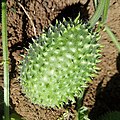|
Cucumis anguria
Cucumis anguria, commonly known as maroon cucumber,[3] West Indian gherkin,[4] maxixe,[5] burr gherkin,[6] cackrey,[7] and West Indian gourd,[3] is a vine that is indigenous to Africa, but has become naturalized in the New World, and is cultivated in many places.[2] It is similar and related to the common cucumber (C. sativus) and its cultivars are known as gherkins.[citation needed] DescriptionCucumis anguria is a thinly stemmed, herbaceous vine scrambling up to 3 meters long. Fruits (4–5 cm × 3–4 cm) grow on long stalks, and are ovoid to oblong. The fruits are covered with long hairs over a surface of spines or wart-like bumps. The inner flesh is pallid to green.[3] DistributionAlthough naturalized in many parts of the New World, Cucumis anguria is indigenous only to Africa, in the following countries: Angola; Botswana; the Democratic Republic of the Congo; Malawi; Mozambique; Namibia; South Africa (KwaZulu-Natal, Limpopo, Mpumalanga); Eswatini; Tanzania; Zambia; and Zimbabwe.[2] Cucumis anguria has become naturalized in: Anguilla; Antigua and Barbuda; Australia (Queensland and Western Australia[8]); Barbados; Brazil; Cayman Islands; Costa Rica; Cuba; the Dominican Republic; Ecuador; French Guiana; Grenada; Guadeloupe; Guatemala; Haiti; Honduras; Jamaica; Madagascar; Martinique; Mexico; Netherlands Antilles; Nicaragua; Panama; Peru; Puerto Rico; Saint Lucia; Saint Vincent and Grenadines; Suriname; the United States (California, Florida, Georgia, Massachusetts, Montana, New York, Oregon, Texas, Minnesota, Wisconsin and Washington); Canada (Ontario, Niagara Region, Nova Scotia, Hants County); Venezuela; and both British and American Virgin Islands.[2][4] Cucumis anguria is also cultivated, but not indigenous to, nor yet believed to have become naturalized in these places: Cape Verde; Réunion; Senegal; and parts of the Caribbean not already mentioned above.[2] UsesCucumis anguria is primarily grown (as a crop plant) for its edible fruit, which is used in pickling, as cooked vegetables,[3][9] or eaten raw.[3] The flavor is similar to that of the common cucumber.[10] C. anguria fruits are popular in the northeast and north of Brazil, where they are an ingredient in the local version of cozido (meat-and-vegetable stew).[citation needed] Cucumis anguria has been used in folk medicine to treat ailments of the stomach.[11] PestsCrops are susceptible to attacks by fungi, aphids, and cucumber beetles.[3] SynonymsThis species, Cucumis anguria L., has a name that other species may share:
Gallery
ReferencesWikimedia Commons has media related to Cucumis anguria.
|
||||||||||||||||||||||||||||||||||||








